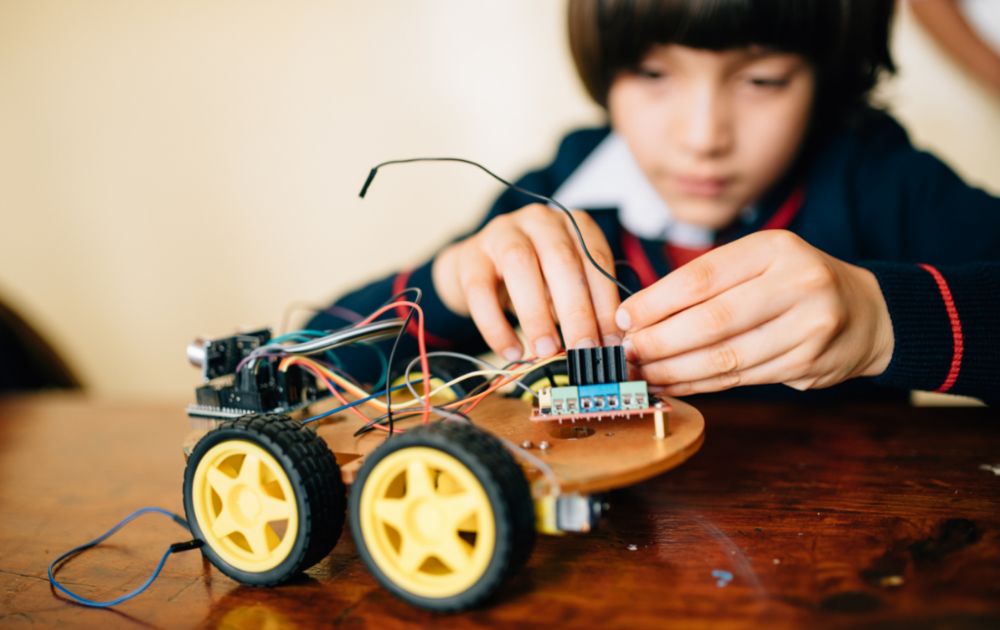
22 Jul Easy & Fun STEM Projects For Children: How to Exercise their Brains!
Ask employment forecasters what fields the big jobs are in today – and which fields are the most richly rewarded financially – and you will no doubt get one or all of these answers: science, technology, engineering, and mathematics, or STEM, for short.
And children love these areas, at least in their early years. In the past, however, if their interest began to wane somewhere around age four or five, they were encouraged to explore other things, to go in whatever direction their hearts, and their talents, took them.
Today, parents and educators have realized that STEM fields aren’t just opportunities for future employment, they are fascinating areas of knowledge in their own right. The fact that they may present a child with an exciting and lucrative employment opportunity down the road one day is a wonderful bonus. But it’s vital to keep that spark alive in children while they’re young, and engaging them in fun and intriguing projects designed for their age group is the best way to keep the flame burning, so to speak.
Here we’ve got some ideas to share with you, projects you can do with your little ones that involve, mostly, household products and other items you’ve likely got laying around under the sink, or in the arts & crafts cupboard you keep stocked for rainy days. Most of these can be made more complicated – or easier – to be customized to your child’s age and comprehension level.
At the end of this post, we offer a link to a website that has plenty of other project ideas and information on where to get supplies, books, and more for STEM projects geared to all age groups.
Science & engineering:
An “oil spill.”
This is incredibly simple and the concept is fairly easy for children of all ages to grasp. Simply put some water in a jar (perhaps two or three cups) and add about one-third a cup of oil and one or two feathers, or one for each child doing the project. Then pass out cloths, paper towels, rags or sponges, and ask your child to remove as much oil as they can while leaving as much water in the jar as possible. Ask them to also remove a feather and try to gently remove the oil. This project teaches the risks of oil spills to nature, and also asks your child how to clean up an “accident” of this type. It draws on science, because of the impact of oil on water. And it focuses on environmental issues, too, and engineering because the oil has to be extracted from both the water and the feathers.
Depending on how old your child is, you can then move on to the consequences of an oil spill, and offer examples, like the Deep Water Horizon disaster in Louisiana in 2010. However, be sure your child is able to process information like this.
Mathematics:

There was a time when learning math made some children glaze over with boredom, but not anymore! Learning their numbers can even get them up and out of their chairs, with this easy game that’s right for every preschooler and kindergarten child.
Sticky Notes Numbers Game:
Tape or glue a large sheet of paper on the wall. Put rows of number groupings in vertical columns, either just dots or, if you’re feeling creative, use symbols of some kind, like pieces of fruit.
Then have the children look around the house for sticky notes with numbers written on them, like “five,” “nine,” and so on. Ask them to then bring the sticky note they found over to the corresponding number grouping – it couldn’t be easier. The hunt for the notes gets them moving, and it is a lot more fun than simply memorizing large columns of numbers!
Technology:
Stop Motion Movie Making:
Your children have probably seen stop motion videos online, and if they are curious about how they are made, you’ll be happy to know it’s surprisingly easy to do one at home.
Here’s all you need:
- a smart phone or laptop;
- a tripod or other stabilizer;
- a box or basket full of toys and small animals to use as the “cast.”
- a cloth backdrop, black or another dark fabric.
Help your children choose the storyline and characters, and then pose them in front of the laptop or phone camera, about 1-2 feet apart.
Ask them to snap a photo, then move each cast member slightly and snap again. Repeat this process 20 or 30 times.
Once the children are satisfied that their story is complete, play the pictures back at a rapid clip. The frames will progress quickly, and all the characters will appear to be moving, at a natural pace, smoothly and easily.
There are free apps online that help you with stop motion video making. Go to:http://www.tinkerlab.com/stop-motion-video to find more information and get a free app for your children.
Engineering:
Make a hand-crank winch:

Here’s what you need:
- cardboard tubes, like those from empty paper towel rolls;
- adhesive tape;
- a spool, like one from a ribbon wheel;
- a pencil;
- scissors;
- a small box or basket.
Here’s what comes next:
- attach the tubes with tape to a firm surface, like a sheet of construction paper;
- use the pencil to determine how far apart they are – the straw has to fit between them;
- put a small hole at the top, on the inside of each tube, just big enough to accommodate the pencil’s ends;
- secure the string to the spool and then the string to the pencil;
- go ahead and crank your winch from one end of the pencil! Once your children turn it and see it lift the basket, experiment with slightly heavier objects and see how much weight the winch can handle.
For lots more on STEM projects, check out: http://www.rasmussen.edu/simple-stem-projects-for-kids.
Enjoy watching your children learn!